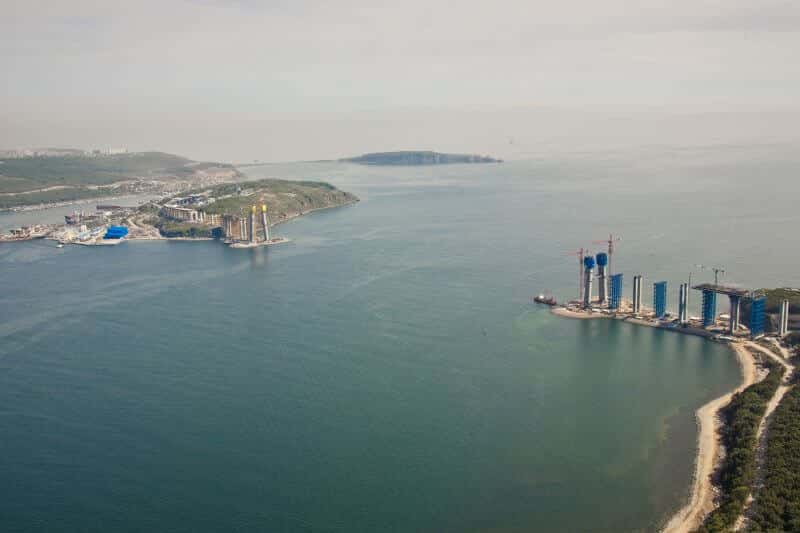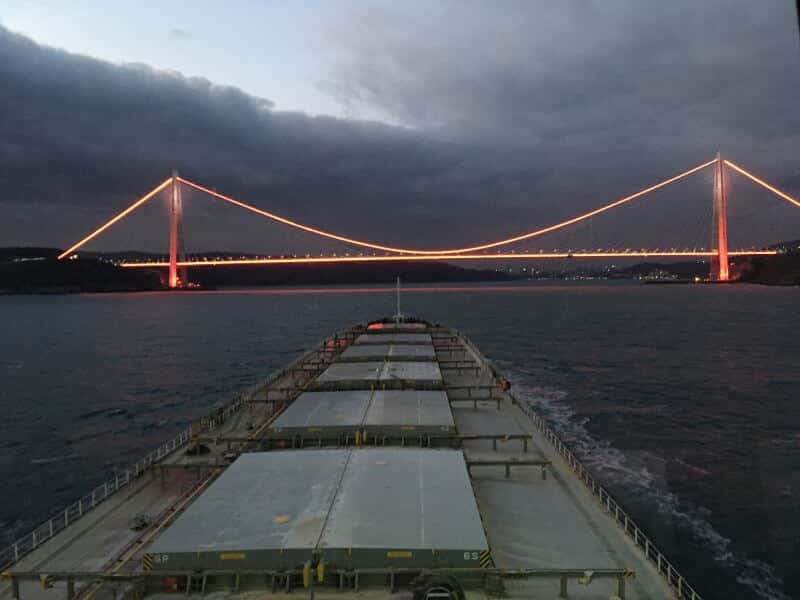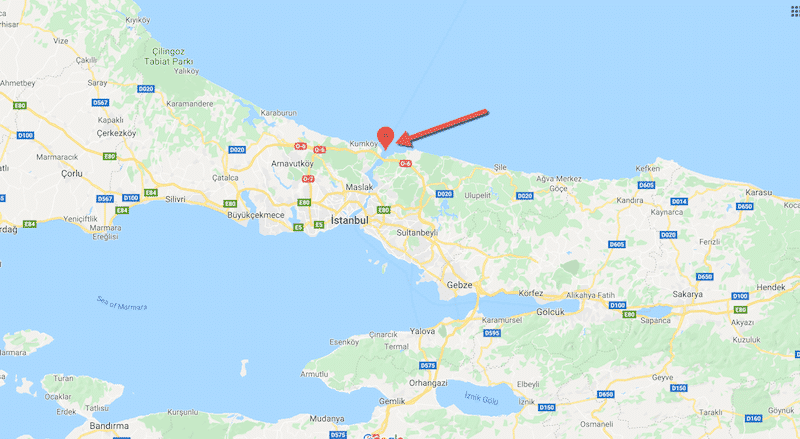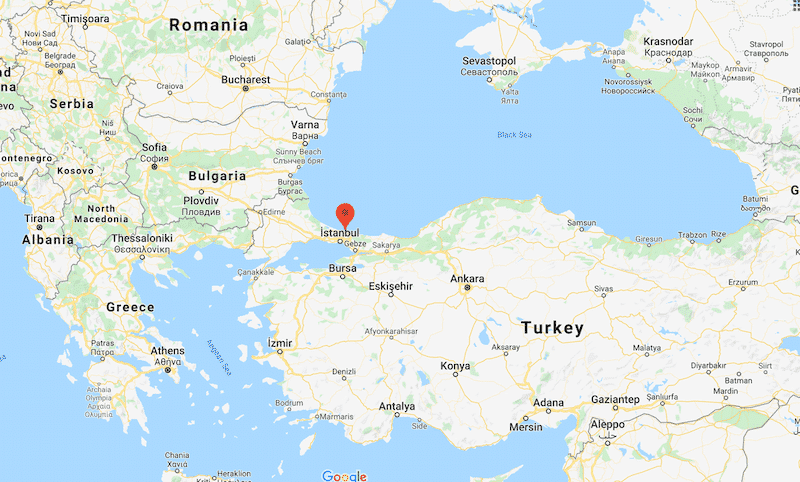6 Bosphorus Strait Facts You Must Know
Bosphorus strait is a natural strait located in northwestern Turkey, connecting the Black Sea to the Sea of Marmara. In ancient times, the Black Sea had no outlet, and its water level was lower than the Aegean and the Marmara Sea.
Also known as the Strait of Istanbul, it links the European part of the city with its Asian part and thus remains a strategic waterway in the region. The Bosphorus strait has played a significant role in world maritime trade for centuries.
How long is the Bosphorus Strait?
This iconic waterway has a length of 31 kilometres (19 miles) and a width that varies between 730-3300 meters.
Turkey’s crucial maritime transit route has maximum width at the northern entrance and a minimum width between the Ottoman fortifications of Rumelihisarı and Anadoluhisarı, becoming one of the world’s most difficult waterways. The strait has a maximum depth of 110 meters (360 ft).
What is Bosphorus Strait Important?
Bosphorus Strait has a significant place on the international maritime map as it is a busy waterway that witnesses the presence of many ships and oil tankers daily, in addition to the local fishing and passenger boats.
The Bosphorus strait’s importance lies in the fact that it is a significant shipping route that links the Black Sea with the world’s oceans. Known as Bogazici in Turkish, it connects the Black Sea with the Marmara Sea and Dardanelles Strait.

Bosphorus Strait Map
As seen on the map, the Bosphorus strait map is an important shipping channel with a strategic location.
Here are some essential facts about the Bosphorus strait of Turkey.
Heavy traffic – Extremely Busy Shipping Route
The increasing number of vessels passing through the Bosphorus strait makes it one of the world’s busiest maritime passages. It is estimated that the strait makes way for around 48.000 ships annually, reportedly three and four times denser than the traffic of the Suez Canal and the Panama Canal, respectively.
The traffic in the strait increased enormously after the signing of the Montreux Convention in 1936. Under the Montreux Convention, the strait provides the right of free passage to merchant’s vessels, while the transit of warships is subject to restrictions. The data shows traffic increased from 4,500 in 1934 to 49,304 in 1998.
But, the number of vessels passing through the strait has decreased since 2002, thanks to the new restrictions placed on oil tanker transit in 2002, banning the nighttime transit for ships longer than 200 meters.
However, it is estimated that the strait witnessed the passage of 43544 ships in 2015.
Difficult waterway for ships – Narrow Channel With High Traffic
The Bosphorus strait is one of the world’s most difficult waterways to navigate, thanks to the narrow width at some parts of the waterway. The channel is only half a mile wide at the narrowest point, posing a hurdle to the oil tankers and other vessels using the strait.
In addition, the swift current in the strait also adds to the difficulty—the current flows from north to south and the subsurface countercurrent results in swirls and eddies. Similarly, the winds from the north make it very difficult to move from the other end.
Chokepoint for the maritime transit of oil – Popular Shipping Route
The Bosphorus strait is one of the world’s critical maritime routes for oil transportation from the Caspian Sea region and Russia to areas including Asia, Western and Southern Europe.
Around 38 per cent of Russia’s, one of the world’s biggest maritime crude oil producers, marine crude oil exports benefits from the strait.
The strait is also the primary oil export route for Eurasian countries such as Azerbaijan and Kazakhstan. It is estimated that more than three pct of the global supply or, in other words, around 3 million barrels of oil per day and 20 million tons/year of petroleum products pass through this iconic waterway.
Highly Fished Strait – Famous Fishing Spot
The position of the Bosporus strait, which connects the Mediterranean to the Black Sea, makes it a hub of fishing activities. The nature of currents and the differences in water temperature attract fish to the strait, contributing to the region’s economy.
The fish variety available in the strait differs according to the season, thanks to the migration of fish between the Black Sea and the Marmara Sea at different times of the year. In addition to fish, the strait acts as an ecological tunnel that hosts the two-way passing of various marine organisms between the two waterbodies.
Bridges of Bosphorus strait – Heavy Tourism
Three suspension bridges over the Bosphorus Strait, shuttling traffic between two continents. The first Bosporus, or Boğaziçi Bridge, 1,074 m (3,524 ft) long, was opened for business in 1973, while the second (Fatih Sultan Mehmet Bridge), 1,090 m (3,576 ft) long suspension bridge is a 5-kilometre distance from the other, was completed in 1988. It spans from Anadolu Hisari to Rumeili Hisari.
The third, Yavuz Sultan Selim Bridge, was inaugurated in August 2016. Located at the entrance to the Black Sea, the bridge has a length of 1408 meters (4619 ft). These bridges, built over deferent decades, create a vast network of roads and contribute significantly to the movement of goods in and out of Turkey.
Many famous Ottoman Palaces, buildings, fortresses and neighborhoods like the Galata, Dolmabahce Palace, Ortaköy, Rumeli fortress, Besiktas, Istinye, Kanlica, Arnavutköy, Tarabya, Sariyer, Ciragan Palace, Bebek, Beykoz, Yeniköy and Yildiz Palace lie along the Strait.

Tunnels of Bosphorus strait
The Bosphorus strait has two tunnels passing under it. One, called Marmaray, runs between the neighbourhoods of Uskudar and Yenikapi. Opened in October 2013, this commuter rail line tunnel spans 76.6 km (47.6 mi) between Europe and Asia.
The second tunnel is called Eurasia Tunnel and runs between Kazlicesme and Goztepe neighbourhoods in Asia and Europe, respectively. Open in December 2016, the tunnel allows the entry of only motor vehicles, including cars and minibuses.
Turkey has barred the passage of warships from any country in the Bosphorus and Dardanelles Straits following Russia’s invasion of Ukraine.
Do you know any other important Bosphorus strait fact that can be added to this list?
Let us know in the comments below.
Frequently Asked Questions
1. Why is the Bosphorus Strait important?
It has been one of the most important maritime routes since ancient times. Today, it is vital for the transportation of oil from the Caspian Sea region and Russia to areas including the regions of Asia, Easter and Western Europe.
2. What does Bosphorus Strait connect?
It is an essential strategic waterway that links the Black Sea with the World’s oceans. It also separates Asian Turkey or Anatolia from European Turkey.
3. Who owns the Bosphorus Strait?
Per the 1936 Montreux Convention, Turkey controls the passage of warships in the Bosphorus and Dardanelles Strait, the Black Sea and the Mediterranean Sea. During peacetime, its primary function is freedom of passage.
4. Is Bosphorus Strait closed to Russian ships?
After the Russian attack on Ukraine, the Turkish President closed the Bosphorus and Dardanelles Strait to military traffic to maintain peace and security in the region.
5. Are waters of the Bosphorus Strait salty?
The Black Sea is fed by many rivers and also rainwater. Since its water flows into the Bosphorus Strait, the waterway does not have very salty surface water. It has a north-south surface current, which is quite fast, making it impossible to swim upstream.
You might also like to read
- 10 Interesting Facts About The Straits Of Gibraltar
- 10 Facts Of the Gulf Of Aden You Must Know
- 7 Interesting Facts About The Scapa Flow
- 15 Amazing Facts About Coral Reefs
Disclaimer: The author’s views expressed in this article do not necessarily reflect the views of Marine Insight. Data and charts, if used in the article, have been sourced from available information and have not been authenticated by any statutory authority. The author and Marine Insight do not claim it to be accurate nor accept any responsibility for the same. The views constitute only the opinions and do not constitute any guidelines or recommendations on any course of action to be followed by the reader.
The article or images cannot be reproduced, copied, shared or used in any form without the permission of the author and Marine Insight.
Do you have info to share with us ? Suggest a correction
Latest Maritime Knowledge Articles You Would Like:
Subscribe To Our Newsletters
By subscribing, you agree to our Privacy Policy and may receive occasional deal communications; you can unsubscribe anytime.


















Good research, but poorly written..
Thanks, I learned a lot. Was the Bosphorus important in ancient times as well?